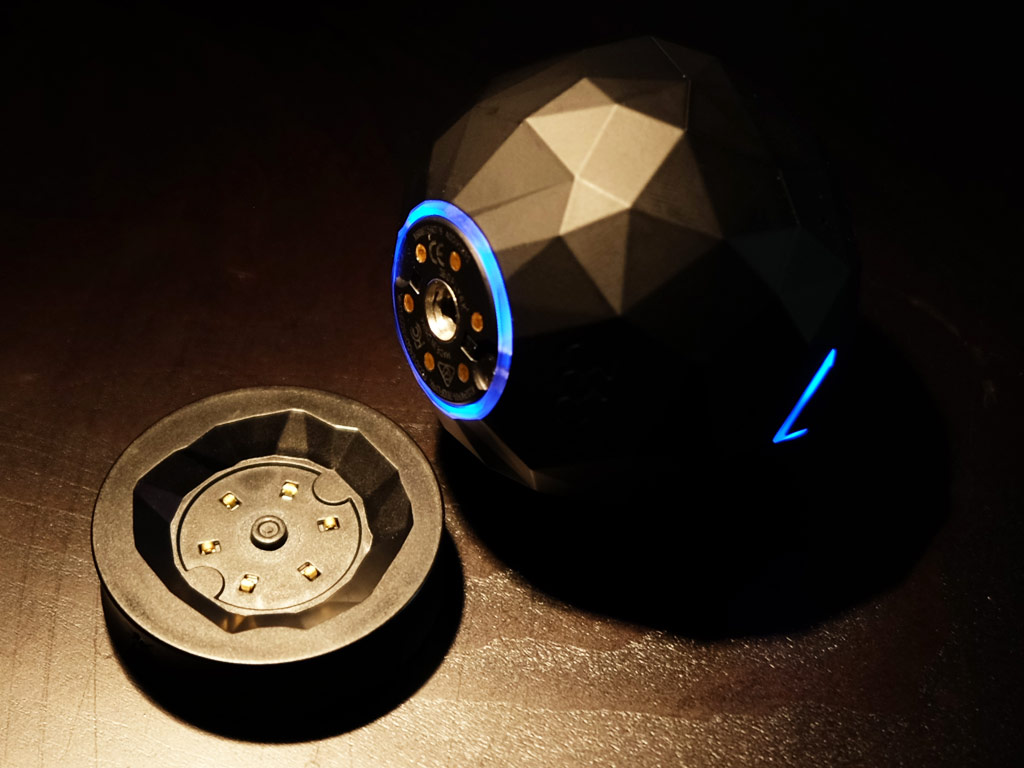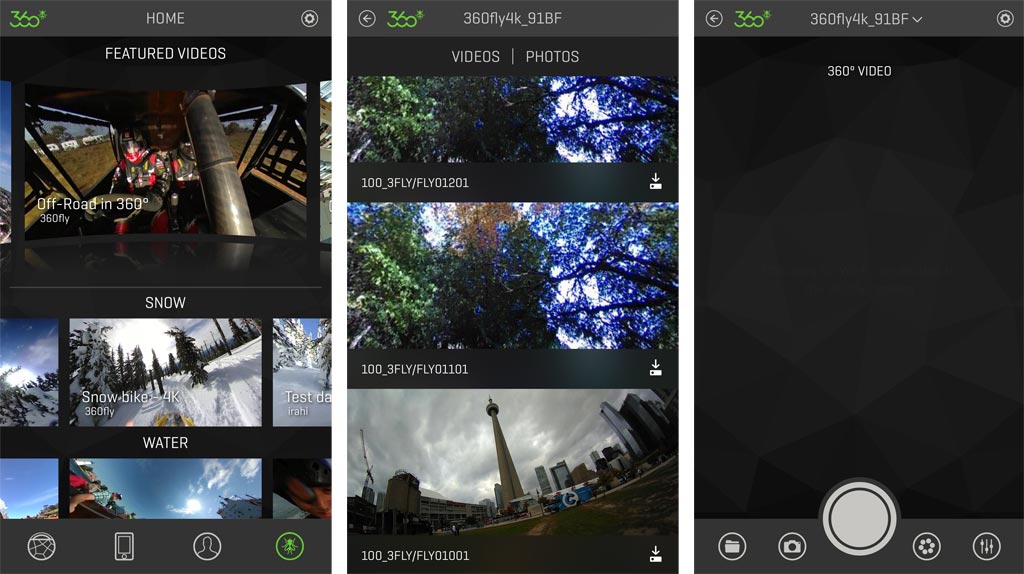
Great images will always look great in 2D, but when you can shoot from a 360-degree point of view, the perspective changes. That’s because the perspective is entirely interactive, letting you move or pan the image in any direction to get a different angle. The 360fly 4K is a 360 camera that captures the world that way, and is made to do it in rugged situations.
The emergence of 360 cameras is partly tied to that of virtual reality, or VR. Saving video and photos shot in 360-degrees can then be viewed from a first-person view through a VR headset for a more immersive feeling—almost like you were there.
360fly all around Design
To be clear, the 360fly 4K is technically a 360-degree camera, but because it only uses one spherical lens, it maxes out at 240-degrees vertically. What that means is the resulting image has a ‘blind spot’ that appears at the bottom of every photo or video shot with it.
Most 360 cameras use two lenses to shoot from both sides, with software stitching them together to create the full 360-degree angle. The 360fly 4K doesn’t stitch anything because there is no second lens, so the process in recording or shooting is less complex under the hood.
Despite the visual limitation, the camera is built with the elements in mind. Smaller than a tennis ball, it’s not a big device, though its rounded design makes placement both easy and challenging, depending on what you have in mind. I’ll get to that in a bit.
The rubberized layer helps the camera achieve its 1ATM rating for water resistance, meaning it can shoot while submerged down to 30 feet. Snow and rain won’t affect it, either, making it ideal for outdoor activities in all seasons. The lens sits at the top, and is easily the most vulnerable part of the camera. The glass covering it is tough, but avoiding heavy contact would be a good idea.

There are dual microphones on either side, with a solo button that records and stops. The surface underneath is flatter to accommodate placing it on any flat surface, along with a standard screw mount to put it on a tripod, selfie stick or special mount (like on a helmet or vehicle). The charging area here is magnetic, so the charging cradle that comes in the package with the camera is one of those accessories you can’t afford to lose. Unfortunately, the camera doesn’t support wireless charging with Qi-enabled pads.
There is 64GB of internal storage, and no memory card expansion available. Not that you would probably need it, as 64GB is plenty, especially when transferring content is easy.
Setup
The 360fly 4K works with both iOS and Android through the free 360fly app. It uses a Wi-Fi Direct connection to pair with a phone or tablet for the initial setup, where you can choose to set up and register a free account (you don’t have to). Within minutes, a live view from the camera should appear on the mobile device screen. It can be viewed either by swiping in any direction or simply moving the device in any direction. Pinching will zoom in more.
It will record in 4K resolution (2880 x 2880) at either 24fps or 30fps. It can do 60fps, albeit at a lower resolution of 1728 x 1728, so image quality does take a hit, as a result. At full 4K resolution, you are looking at three hours of video total on the 64GB storage. To make room, files can be transferred wirelessly to the paired mobile device on the fly, or to a computer when the charging cradle is plugged in directly.

 Because of that Wi-Fi Direct connection, the app can act as a remote shutter to record and stop from enough of a distance to get out of the shot. So, hiding behind a wall or object while the camera sits on a surface or tripod, for example, could yield an image where you don’t appear. Or you can set it on a timer so you can pose where you want to be.
Because of that Wi-Fi Direct connection, the app can act as a remote shutter to record and stop from enough of a distance to get out of the shot. So, hiding behind a wall or object while the camera sits on a surface or tripod, for example, could yield an image where you don’t appear. Or you can set it on a timer so you can pose where you want to be.
Angling the camera is always an option if you want to focus more on what’s directly in front, but it’s not really necessary. The 360fly 4K captures enough right in front, but if you want to push the blind spot further down, a slight angle forward may help do that. The consequence in doing that, however, is that the spot elevates behind.
Performance
The unique design impacts how footage turns out. Zoom out to view an image in its circular format and detail appears crisp and vibrant. The more you zoom in for a closer look, the more you notice some of the shortcomings. Detail gets lost, and there is a tendency for purple along the fringes. This can depend on where and when you’re shooting. Bright daylight with little contrast reduces that effect. Darker shadows with bright highlights force one to outdo the other.
 Low-light situations are more difficult, partly because the aperture isn’t super wide, and the image sensor not big enough to take in more light. It’s not that you can’t shoot in low-light or at night, it’s that there’s more noise and less detail to work with. Shooting in either of those situations requires light to illuminate the scene to see more.
Low-light situations are more difficult, partly because the aperture isn’t super wide, and the image sensor not big enough to take in more light. It’s not that you can’t shoot in low-light or at night, it’s that there’s more noise and less detail to work with. Shooting in either of those situations requires light to illuminate the scene to see more.
For that reason, this is a camera that you will probably use more in daylight settings. Its durability means it can be set up to work in anything from snowboarding to whitewater rafting. Mount it on a car, or on a helmet—while it’s raining. There is versatility here, and that’s probably the 360fly 4K’s biggest asset. It’s not great at capturing audio, despite having two pinhole microphones, so the sounds of the action are going to be decent, but not outstanding.
The app offers basic editing tools, including for exposure, contrast and saturation, helping to offset some of the excesses. Playing with those settings is hit or miss — it may not fix it, but it will help.
There is free desktop editing software 360fly offers for Windows PCs and Macs, allowing you to trim and edit footage. It’s pretty barebones, so don’t expect many features, but it is more varied than its mobile counterpart, and is one way to post directly to YouTube, Facebook or 360fly’s own video uploading service.
Final Thoughts
To be fair, the 360fly 4K struggles in the same way other 360 cameras do. Even shooting at high resolutions, these cameras will eventually need to go higher to sharpen everything from every angle. “Flatter” 4K cameras, like the GoPro, produce better imagery because the optics and image sensor don’t have to do as much work.
That’s not to say this camera isn’t useful, I’m only underlining the fact it is better suited to enthusiasts and early adopters because 360-degree video still has plenty of room to evolve.
The 360fly 4K is available now.



